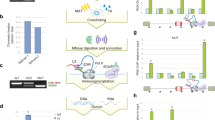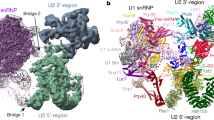Abstract
Messenger RNAs produced by splicing are translated more efficiently than those produced from similar intronless precursor mRNAs (pre-mRNAs). The exon-junction complex (EJC) probably mediates this enhancement; however, the specific link between the EJC and the translation machinery has not been identified. The EJC proteins Y14 and magoh remain bound to spliced mRNAs after their export from the nucleus to the cytoplasm and are removed only when these mRNAs are translated. Here we show that PYM, a 29-kDa protein that binds the Y14–magoh complex in the cytoplasm, also binds, via a separate domain, to the small (40S) ribosomal subunit and the 48S preinitiation complex. Furthermore, PYM knockdown reduces the translation efficiency of a reporter protein produced from intron-containing, but not intronless, pre-mRNA. We suggest that PYM functions as a bridge between EJC-bearing spliced mRNAs and the translation machinery to enhance translation of the mRNAs.
This is a preview of subscription content, access via your institution
Access options
Subscribe to this journal
Receive 12 print issues and online access
$189.00 per year
only $15.75 per issue
Buy this article
- Purchase on Springer Link
- Instant access to full article PDF
Prices may be subject to local taxes which are calculated during checkout





Similar content being viewed by others
References
Reed, R. Mechanisms of fidelity in pre-mRNA splicing. Curr. Opin. Cell Biol. 12, 340–345 (2000).
Hastings, M.L. & Krainer, A.R. Pre-mRNA splicing in the new millennium. Curr. Opin. Cell Biol. 13, 302–309 (2001).
Zhang, J., Sun, X., Qian, Y., LaDuca, J.P. & Maquat, L.E. At least one intron is required for the nonsense-mediated decay of triosephosphate isomerase mRNA: a possible link between nuclear splicing and cytoplasmic translation. Mol. Cell. Biol. 18, 5272–5283 (1998).
Lu, S. & Cullen, B.R. Analysis of the stimulatory effect of splicing on mRNA production and utilization in mammalian cells. RNA 9, 618–630 (2003).
Nott, A., Meislin, S.H. & Moore, M.J. A quantitative analysis of intron effects on mammalian gene expression. RNA 9, 607–617 (2003).
Matsumoto, K., Wassarman, K.M. & Wolffe, A.P. Nuclear history of a pre-mRNA determines the translational activity of cytoplasmic mRNA. EMBO J. 17, 2107–2121 (1998).
Dostie, J. & Dreyfuss, G. Translation is required to remove Y14 from mRNAs in the cytoplasm. Curr. Biol. 12, 1060–1067 (2002).
Wiegand, H.L., Lu, S. & Cullen, B.R. Exon junction complexes mediate the enhancing effect of splicing on mRNA expression. Proc. Natl. Acad. Sci. USA 100, 11327–11332 (2003).
Hsu, I.-W. et al. Phosphorylation of Y14 modulates its interaction with proteins involved in mRNA metabolism and influences its methylation. J. Biol. Chem. 280, 34507–34512 (2005).
Nott, A., Le Hir, H. & Moore, M.J. Splicing enhances translation in mammalian cells: an additional function of the exon junction complex. Genes Dev. 18, 210–222 (2004).
Kataoka, N., Diem, M.D., Kim, V.N., Yong, J. & Dreyfuss, G. Magoh, a human homolog of Drosophila mago nashi protein, is a component of the splicing-dependent exon-exon junction complex. EMBO J. 20, 6424–6433 (2001).
Kataoka, N. et al. Pre-mRNA splicing imprints mRNA in the nucleus with a novel RNA-binding protein that persists in the cytoplasm. Mol. Cell 6, 673–682 (2000).
Kim, V.N., Kataoka, N. & Dreyfuss, G. Role of the nonsense-mediated decay factor hUpf3 in the splicing-dependent exon-exon junction complex. Science 293, 1832–1836 (2001).
Le Hir, H., Gatfield, D., Braun, I.C., Forler, D. & Izaurralde, E. The protein Mago provides a link between splicing and mRNA localization. EMBO Rep. 2, 1119–1124 (2001).
Le Hir, H., Izaurralde, E., Maquat, L.E. & Moore, M.J. The spliceosome deposits multiple proteins 20–24 nucleotides upstream of mRNA exon-exon junctions. EMBO J. 19, 6860–6869 (2000).
Chan, C.C. et al. eIF4A3 is a novel component of the exon junction complex. RNA 10, 200–209 (2004).
Degot, S. et al. Association of the breast cancer protein MLN51 with the exon junction complex via its speckle localizer and RNA binding module. J. Biol. Chem. 279, 33702–33715 (2004).
Palacios, I.M., Gatfield, D., St. Johnston, D. & Izaurralde, E. An eIF4AIII-containing complex required for mRNA localization and nonsense-mediated mRNA decay. Nature 427, 753–757 (2004).
Shibuya, T., Tange, T.O., Sonenberg, N. & Moore, M.J. eIF4AIII binds spliced mRNA in the exon junction complex and is essential for nonsense-mediated decay. Nat. Struct. Mol. Biol. 11, 346–351 (2004).
Ferraiuolo, M.A. et al. A nuclear translation-like factor eIF4AIII is recruited to the mRNA during splicing and functions in nonsense-mediated decay. Proc. Natl. Acad. Sci. USA 101, 4118–4123 (2004).
Maquat, L.E. & Carmichael, G.G. Quality control of mRNA function. Cell 104, 173–176 (2001).
Hilleren, P. & Parker, R. Mechanisms of mRNA surveillance in eukaryotes. Annu. Rev. Genet. 33, 229–260 (1999).
Culbertson, M.R. RNA surveillance. Unforeseen consequences for gene expression, inherited genetic disorders and cancer. Trends Genet. 15, 74–80 (1999).
Gehring, N.H., Neu-Yilik, G., Schell, T., Hentze, M.W. & Kulozik, A.E. Y14 and hUpf3b form an NMD-activating complex. Mol. Cell 11, 939–949 (2003).
Gehring, N.H. et al. Exon-junction complex components specify distinct routes of nonsense-mediated mRNA decay with differential cofactor requirements. Mol. Cell 20, 65–75 (2005).
Kashima, I. et al. Binding of a novel SMG-1-Upf1-eRF1-eRF3 complex (SURF) to the exon junction complex triggers Upf1 phosphorylation and nonsense-mediated mRNA decay. Genes Dev. 20, 355–367 (2006).
Hentze, M.W. & Kulozik, A.E. A perfect message: RNA surveillance and nonsense-mediated decay. Cell 96, 307–310 (1999).
Gonzalez, C.I., Bhattacharya, A., Wang, W. & Peltz, S.W. Nonsense-mediated mRNA decay in Saccharomyces cerevisiae. Gene 274, 15–25 (2001).
Wagner, E. & Lykke-Andersen, J. mRNA surveillance: the perfect persist. J. Cell Sci. 115, 3033–3038 (2002).
Kim, V.N. et al. The Y14 protein communicates to the cytoplasm the position of exon-exon junctions. EMBO J. 20, 2062–2068 (2001).
Tange, T.O., Shibuya, T., Jurica, M.S. & Moore, M.J. Biochemical analysis of the EJC reveals two new factors and a stable tetrameric protein core. RNA 11, 1869–1883 (2005).
Ballut, L. et al. The exon junction core complex is locked onto RNA by inhibition of eIF4AIII ATPase activity. Nat. Struct. Mol. Biol. 12, 861–869 (2005).
Mohr, S.E., Dillon, S.T. & Boswell, R.E. The RNA-binding protein Tsunagi interacts with Mago Nashi to establish polarity and localize oskar mRNA during Drosophila oogenesis. Genes Dev. 15, 2886–2899 (2001).
Newmark, P.A., Mohr, S.E., Gong, L. & Boswell, R.E. mago nashi mediates the posterior follicle cell-to-oocyte signal to organize axis formation in Drosophila. Development 124, 3197–3207 (1997).
Kawano, T., Kataoka, N., Dreyfuss, G. & Sakamoto, H. Ce-Y14 and MAG-1, components of the exon-exon junction complex, are required for embryogenesis and germline sexual switching in Caenorhabditis elegans. Mech. Dev. 121, 27–35 (2004).
Li, W., Boswell, R. & Wood, W.B. mag-1, a homolog of Drosophila mago nashi, regulates hermaphrodite germ-line sex determination in Caenorhabditis elegans. Dev. Biol. 218, 172–182 (2000).
Hachet, O. & Ephrussi, A. Drosophila Y14 shuttles to the posterior of the oocyte and is required for oskar mRNA transport. Curr. Biol. 11, 1666–1674 (2001).
Bono, F. et al. Molecular insights into the interaction of PYM with the Mago-Y14 core of the exon junction complex. EMBO Rep. 5, 304–310 (2004).
Mechler, B. & Vassalli, P. Membrane-bound ribosomes of myeloma cells. I. Preparation of free and membrane-bound ribosomal fractions. Assessment of the methods and properties of the ribosomes. J. Cell Biol. 67, 1–15 (1975).
Ishigaki, Y., Li, X., Serin, G. & Maquat, L.E. Evidence for a pioneer round of mRNA translation: mRNAs subject to nonsense-mediated decay in mammalian cells are bound by CBP80 and CBP20. Cell 106, 607–617 (2001).
Lejeune, F., Ishigaki, Y., Li, X. & Maquat, L.E. The exon junction complex is detected on CBP80-bound but not eIF4E-bound mRNA in mammalian cells: dynamics of mRNP remodeling. EMBO J. 21, 3536–3545 (2002).
Chiu, S.Y., Lejeune, F., Ranganathan, A.C. & Maquat, L.E. The pioneer translation initiation complex is functionally distinct from but structurally overlaps with the steady-state translation initiation complex. Genes Dev. 18, 745–754 (2004).
Hosoda, N., Kim, Y.K., Lejeune, F. & Maquat, L.E. CBP80 promotes interaction of Upf1 with Upf2 during nonsense-mediated mRNA decay in mammalian cells. Nat. Struct. Mol. Biol. 12, 893–901 (2005).
Merrick, W.C., Kemper, W.M. & Anderson, W.F. Purification and characterization of homogeneous initiation factor M2A from rabbit reticulocytes. J. Biol. Chem. 250, 5556–5562 (1975).
Ventoso, I. et al. Translational resistance of late alphavirus mRNA to eIF2alpha phosphorylation: a strategy to overcome the antiviral effect of protein kinase PKR. Genes Dev. 20, 87–100 (2006).
Merz, C., Urlaub, H., Will, C.L. & Lührmann, R. Protein composition of human mRNPs spliced in vitro and differential requirements for mRNP protein recruitment. RNA 13, 116–128 (2007).
Zhang, Z. & Krainer, A.R. Splicing remodels messenger ribonucleoprotein architecture via eIF4A3-dependent and -independent recruitment of exon junction complex components. Proc. Natl. Acad. Sci. USA 104, 11574–11579 (2007).
Dreyfuss, G., Kim, V.N. & Kataoka, N. Messenger-RNA-binding proteins and the messages they carry. Nat. Rev. Mol. Cell Biol. 3, 195–205 (2002).
Maquat, L.E. Nonsense-mediated mRNA decay: splicing, translation and mRNP dynamics. Nat. Rev. Mol. Cell Biol. 5, 89–99 (2004).
Zoll, W.L., Horton, L.E., Komar, A.A., Hensold, J.O. & Merrick, W.C. Characterization of mammalian eIF2A and identification of the yeast homolog. J. Biol. Chem. 277, 37079–37087 (2002).
Komar, A.A. et al. Novel characteristics of the biological properties of the yeast Saccharomyces cerevisiae eukaryotic initiation factor 2A. J. Biol. Chem. 280, 15601–15611 (2005).
Friesen, W.J. & Dreyfuss, G. Specific sequences of the Sm and Sm-like (Lsm) proteins mediate their interaction with the spinal muscular atrophy disease gene product (SMN). J. Biol. Chem. 275, 26370–26375 (2000).H
Acknowledgements
We thank members of our laboratory, especially D. Battle and J. Yong, for stimulating discussions and comments on this manuscript; H. Sheng and R. Olszewski for technical assistance; S. Grill for secretarial assistance; I. Mattaj (European Molecular Biology Laboratory) for the CBP20 and CBP80 antibodies; G. Van Duyne (University of Pennsylvania) for the GST-TEV expression vector; and the New York University Protein Analysis Facility for protein microsequencing. G.D. is an Investigator of the Howard Hughes Medical Institute.
Author information
Authors and Affiliations
Corresponding author
Supplementary information
Supplementary Text and Figures
Supplementary Figures 1–4 (PDF 507 kb)
Rights and permissions
About this article
Cite this article
Diem, M., Chan, C., Younis, I. et al. PYM binds the cytoplasmic exon-junction complex and ribosomes to enhance translation of spliced mRNAs. Nat Struct Mol Biol 14, 1173–1179 (2007). https://doi.org/10.1038/nsmb1321
Received:
Accepted:
Published:
Issue Date:
DOI: https://doi.org/10.1038/nsmb1321
This article is cited by
-
Nonsense-mediated mRNA decay pathway in plants under stress: general gene regulatory mechanism and advances
Planta (2024)
-
Exon junction complex components Y14 and Mago still play a role in budding yeast
Scientific Reports (2019)
-
Quality and quantity control of gene expression by nonsense-mediated mRNA decay
Nature Reviews Molecular Cell Biology (2019)
-
Identification of antiviral roles for the exon–junction complex and nonsense-mediated decay in flaviviral infection
Nature Microbiology (2019)
-
Intron specificity in pre-mRNA splicing
Current Genetics (2018)



